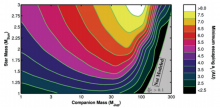
Powering and Shaping Planetary Nebulae: The Physics of Common Envelopes
Published in Astronomy in Focus 29B, 33
(Tuesday, September 27, 2016)
Abstract
The diversity of collimated outflows in post-asymptotic-giant-branch stars and their planetary nebula progeny are often explained by a combination of close binary interactions and accretion. The viability of such scenarios can be tested by comparing kinematic outflow data to determine minimum accretion rates necessary to power observed outflows. While many binary channels have been ruled out with this technique, common envelope interactions can accommodate the current observational constraints, are potentially common, lead to a diverse array of planetary-nebula shapes, and naturally produce period gaps for companions to white dwarfs.